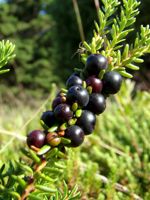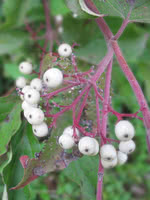Mon-Fri 9am - 5pm Mountain time
Gray Dogwood vs Black Crowberry
Empetrum nigrum
Cornus racemosa
CUSTOM GROW
CUSTOM GROW
Black Crowberry is a native evergreen shrub that forms low, spreading mats. It has unique foliage that spirals around the stem, and small dark berries, giving it visual appeal. The berries are edible, but can be acidic, so they are not generally eaten fresh. In colder climates, the berries develop a sweet-tart flavor and are often dried or used in desserts, jams, and jellies.
This hardy shrub provides food for birds and mammals, while its flowers attract pollinators such as bees. It also serves as a host plant for certain butterflies and moths. Together, these roles make it a key contributor to the health of tundra and boreal ecosystems.
In Newfoundland and Labrador, the berries are known locally as ‘blackberries’ and are enjoyed in jams, jellies, and traditional baked goods such as buns and puddings. In Scandinavia, they continue to be used in liqueurs, wines, and juices.
Gray dogwood is a thicket-forming, deciduous shrub with greenish-white blossoms in open, terminal clusters. Young twigs are red and the fruit pedicels remain conspicuously red into late fall and early winter.
Fruit itself is a white, 1/4 in. drupe that usually does not remain on the shrub for long.
Great for naturalizing wild areas, this shrub attracts birds and other wildlife.

